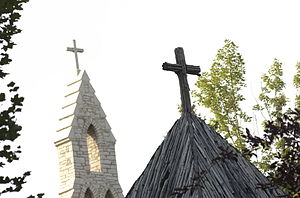- Nashotah House
-
Nashotah House is an Anglo-Catholic seminary of the Episcopal Church (TEC) located in Nashotah, Wisconsin, approximately 30 miles (50 km) from Milwaukee, in the Episcopal Diocese of Milwaukee. The seminary opened its doors in 1842 and received its official charter in 1847. The institution is generally regarded as one of the more theologically conservative seminaries within the Episcopal Church.
In 2007, there were fifty students who lived on campus. The average age of students was 37.5, which means that the school had the youngest student body among Episcopal seminaries. Forty-four of these students were male and six female.[1]
Contents
Degree and certificate programs
Nashotah House offers a variety of degree and certificate programs aimed at training clergy and lay leaders for ministries in the Anglican Communion:
- Doctor of Ministry (D.Min.)
- Master of Sacred Theology (S.T.M.)
- Master of Divinity (M.Div.)
- Master of Theological Studies (M.T.S.)
- Master of Arts in Ministry (M.A. in Ministry)
It also offers a one-year certificate program in Anglican Studies, geared toward students who have received an M.Div. from a non-Anglican institution and wish to be ordained within the Anglican tradition. The M.A. in Ministry degree may be earned through a combination of residential and online study. The M.Div., M.T.S., S.T.M., D.Min. and M.A. in Ministry degrees are accredited by the Association of Theological Schools in the United States and Canada (ATS). [2]
History
Nashotah House was founded by three young deacons of the Episcopal Church: James Lloyd Breck, William Adams, and John Henry Hobart, Jr., all recent graduates of General Theological Seminary in New York City, at the bidding of Bishop Jackson Kemper. Gustaf Unonius was the first graduate.
Nashotah House was, from the beginning, a center for High Church thought and discipline. Breck, the first dean, was highly committed to the principles of the Oxford Movement. Later, famous professors such as James DeKoven would bring Anglo-Catholic worship and practice to the seminary. This began with the daily celebration of the Eucharist as well as the use of vestments, candles, and incense.
In the present controversies affecting the Episcopal Church, Nashotah faculty have come down almost entirely on the side of conservatism in doctrine and morals, favoring traditional conceptions of Christian doctrine and opposition to cultural liberalism. There has been involvement by some of its graduates with the Anglican realignment and continuing Anglican movements, which began in the 1970s.
On 3 April 2009, an historic building which was part of the Nashotah House seminary property was destroyed by fire.[3]
Main buildings
The property of the Nashotah House Episcopal Seminary covers 365 acres (148 ha) of land.[3]
The main buildings of the seminary include:
- Chapel of St. Mary the Virgin
- Sabine Hall (faculty offices, student housing)
- James Lloyd Breck Refectory
- Shelton Hall (bookstore)
- Lewis Hall (administration and faculty offices, the Saint Francis Oratory)
- Kemper Hall (classrooms, student housing, gymnasium)
- Webb Hall (faculty and guest housing, the Chapel of Saints Peter and Paul)
- Library
- The Tender Hearts Day Care Center
There are also apartments for both single and married students, and several houses for the Dean and other faculty, as well as maintenance facilities.
Construction is currently underway for a substantial addition to the Refectory, which will include a large meeting hall and additional classrooms.
Student life
Nashotah began as a community of self-help and it has largely stayed that way. All students have work crew assignments - cleaning bathrooms, mowing lawns, sweeping floors and taking other chores. Daily routine includes Morning Prayer, Mass, breakfast, classes, lunch, and Solemn Evensong. Always anticipated on the campus is the annual St. Laurence Cup, a flag football game played against students from Sacred Heart School of Theology and St. Francis Seminary (Wisconsin).[4] The formerly annual Lavabo Bowl game was played against Seabury-Western Theological Seminary which no longer matriculates students for the traditional Master of Divinity degree. [5]
Notable alumni and faculty
- James DeKoven, faculty member
- Gustaf Unonius, 1845
- Benjamin Franklin Price Ivins, 1907, Bishop of Milwaukee
- Charles Wesley Leffingwell, editor of The Living Church
- Harwood Sturtevant, fourth Bishop of Fond du Lac
- William Walter Webb, professor, president, Bishop of Milwaukee
- William Wallace Horstick, second Bishop of Eau Claire
References
- ^ Mary Frances Schjonberg, "Episcopal seminaries' enrollment statistics show varying trends," (November 6, 2007), episcopallife online (New York: Episcopal Life Online, 2007).
- ^ Nashotah House - Degree Programs
- ^ a b McCrady, Melissa and Sorgi, Jay (2009-04-03). Fire Destroys Historic Seminary Building. Retrieved on 2009-04-03 from http://www.620wtmj.com/news/local/42379197.html.
- ^ The Missioner, Advent 2009 "Sacred Heartbreaker: Anglicans Fall to Romans 14-6," p. 7.
- ^ Seabury-Western Theological Seminary As of the fall of 2008 the seminary will no longer matriculate students for the traditional Master of Divinity degree.
External links
- Nastotah House official website
- Historical resources on Nashotah House
- Nashotah House official photo blog
- Articles about Father James Lloyd Breck and Nashotah House, Wisconsin State Historical Society
Seminaries of The Episcopal Church Berkeley Divinity School at Yale • Bexley Hall • Church Divinity School of the Pacific • Episcopal Divinity School • General Theological Seminary • Nashotah House • Seabury-Western Theological Seminary • Seminary of the Southwest • School of Theology at the University of the South • Trinity School for Ministry • Virginia Theological SeminaryCategories:- Anglo-Catholicism
- Episcopal Church in the United States of America
- Seminaries and theological colleges in Wisconsin
- Anglican seminaries and theological colleges
- Universities and colleges in Wisconsin
- Education in Waukesha County, Wisconsin
- Christianity in Wisconsin
- Educational institutions established in 1842
- Buildings and structures in Waukesha County, Wisconsin
Wikimedia Foundation. 2010.


